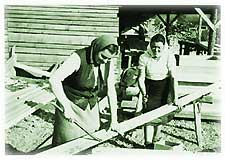Female Workers from the East
Gabrielle Hauch

The reality of life for female workers from the east and from Poland – who were on the next lowest rung of the Nazi racial ladder after Jews and Roma–Sinti was defined by the combination of their gender and their “racially” constructed national and ethnic heritage, and led to a particular form of discrimination. The organised interference in their fertility began in 1942/43 with the relaxation of the prohibition on abortion and the institution of “Foreign Child Care Centres”, as the “racially alien children’s homes” were called, and signalled the beginning of a forced control of these women’s lives, which became increasingly oppressive until the end of the war.
To handle the births and abortions of these women a special “Female Eastern Workers’ Barracks” was set up in the courtyard of the Provincial Clinic for Women in Linz in March 1943, and a “Department for Alien Races” in the General Hospital.Over 1,000 births stand in contrast to 972 abortions – and the proportion tended increasingly towards the abortions towards the end of the war - of which countless were carried out in the seventh month of pregnancy. Comprehensive conditions of forced control, aimed at maintaining production capability, excludes the supposition that these women had freedom of choice. Infants were transferred to twelve specially set up homes across Oberdonau, including the Nazi “Pilot Project” in Spital am Phyrn, which was opened in April 1943. The conditions in these homes – not just in Spital am Phyrn, but also in Gattern, Kreis Schärding, for example – led to a high mortality rate. For the first time it could also be shown in the case of Oberdonau, that children of female workers from the east and Poland were also left in the care of “Aryan” women.